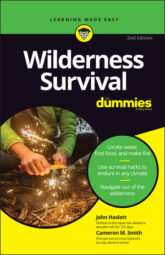Six essentials for surviving in the wild
It takes just an hour or so to gather a few basic items that can help you survive many serious outdoor situations. Put these wilderness essentials in a waterproof baggie and carry them in your backpack, in the glove compartment of your car or snowmobile, in your canoe, etc. Wherever you go, these items should be along for the adventure:
- Cigarette lighter: Wrap with a few turns of duct tape, which can be used as tinder; it burns long and slow. Then lay a fishing hook on the lighter and wrap again, this time with 50 feet of fishing line.
- Heat-reflecting space blanket: Stash this small, lightweight but very effective heat-reflecting poncho. The large silvery surface can also be used to signal potential rescuers.
- Pocket knife or Swiss army-type knife: You don’t need anything elaborate. Just be sure the blade is sharp and the tool has Philips and standard screwdrivers.
- Water purification tablets: Pack enough for several days; the number depends on the type of tablets, so read the instructions carefully. (We assume you always have a water bottle with you outdoors.)
- Mini compass: In most survival situations it’s best to stay put and wait for rescue. But even so, it’s good to include a small compass to know the basic directions, especially if you do have to move.
- Signal mirror or whistle: These items can help you attract the attention of potential rescuers.
Keep a copy of Wilderness Survival For Dummies, 2nd Edition archived as a PDF on your cellphone or device for quick reference.
Taking immediate action when lost or stranded outdoors
Print and laminate the lists appropriate to what you do outdoors, and keep copies in your glove compartment or backpack for quick reference.
On a sinking vessel
- If the vessel has a radio, signal Mayday (spoken three times) and/or activate the Distress button to instantly transmit your position and need of help. If there is no radio, try to call 911 on a cell phone if you’re within roughly 20 miles of shore.
- Secure your life jacket and then make sure everyone in your party is wearing one.
- Activate a life raft downwind in water and then board.
- Clear the sinking site and deploy the sea anchor or drogue.
- After sinking, scavenge the vessel’s debris field for useful items floating on the water’s surface such as rope, water containers, and even spare life jackets.
Lost on a day hike or drive
- Mark your current position on your cellphone or another GPS unit and stay close for at least three days.
- If you’re with a broken-down vehicle, raise the hood to signal distress.
- Follow SeCR (or secure) guidelines to lower stress and regain control of your situation; avoid making decisions based on emotion. SeCR guidelines suggest getting Security by moving away from immediate danger such as a burning vehicle or falling rocks, finding some Comfort by getting out of the elements and into a basic shelter, and being Reassured that not all is lost.
- If your cellphone has signal, text friends or family for help (be sure to include where you are, estimating your location if needed) and then adjust your phone’s settings to conserve battery power.For example, turn your iPhone on Low Power Mode or Doze for Android.
- Attend to body temperature needs, heating or cooling yourself depending on the conditions.
- Secure drinking water and food.
- Begin work on a plan to signal potential rescuers with smoke, fire, a signal mirror, whistle, or other tools you have on hand.
Improvising navigation in the wilderness
The sun, the stars, and a little ingenuity can help you find your way in the wilderness. Remember, the methods are simple and people have been using the heavens to navigate for thousands of years.
Using the shadow stick method
- Plant a long stick in the ground and mark the tip of its shadow with a rock (see Figure 1a).
- Wait 15 minutes and put a rock where the tip of the shadow is now (see Figure 1b). Draw a line connecting the two (see Figure 1c): this is the east-west line.
- Put your left foot at the first rock and your right on the second; you’re now facing due north (see Figure 1d).
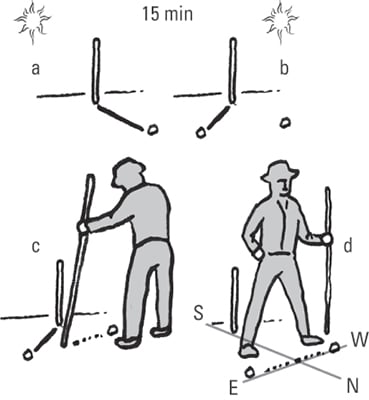
Using the shadow stick navigation method
Following the North Star
The North Star is located between the Big Dipper and Cassiopeia. This method for finding North is always exact. When you’re facing the North Star, west is directly to your left, east, to your right, and south behind you.
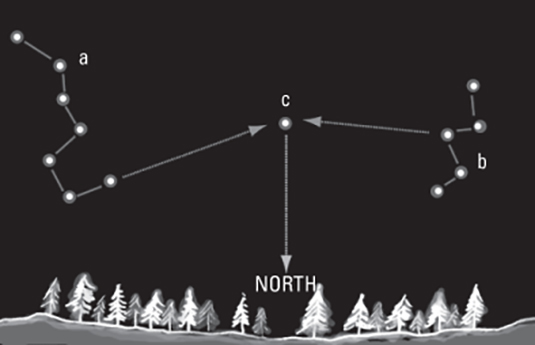
The North Star is located between the Big Dipper and Cassiopeia.
Locating the Southern Cross
The Southern Cross lies between the two Pointer Stars and The False Cross. The Southern Cross points perfectly south only when it’s standing straight up. Otherwise, use an imaginary point to estimate due south, as the figure shows:
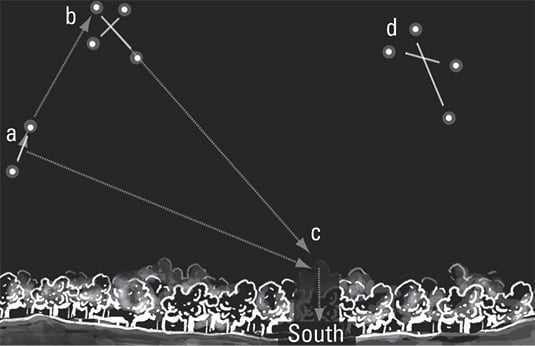
The Southern Cross constellation lies between the two Pointer Stars and the False Cross constellation.
Methods for signaling search-and-rescue teams
When you need help in the wilderness, think of these ways to signal for rescue.
Sending a ground-to-air emergency code
These symbols are universally recognized by search-and-rescue personnel as distress signals. Make sure they are at least 20 feet long and about 5 feet wide so rescuers can see them from the air.
These signals can be made by piling up rocks, stamping or discoloring snow, flattening down tall vegetation; use whatever works in your environment.
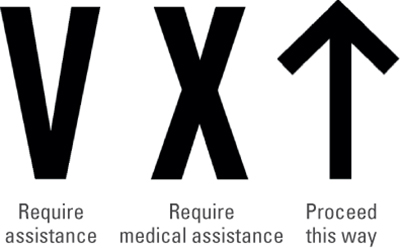
Ground-to-air emergency symbols
Aiming a reflector
You must carefully aim your mirror’s reflection at the aircraft or vessel you wish to signal to be seen. You can use a mirror or other reflective items, such as a cell phone’s shiny face, an old CD, a polished belt buckle or other piece of metal; be creative (though it’s best to always carry a cheap but invaluable signal mirror).
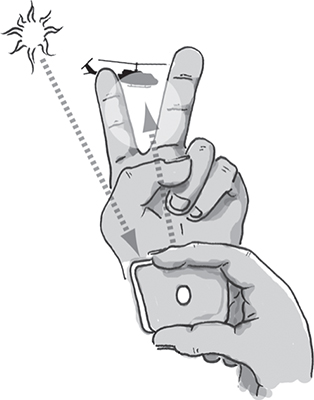
Aiming a reflector to signal for help
Making a group splash
If a ring of people all kick simultaneously, the water in the center turns white, briefly, which can be seen against the blue ocean.
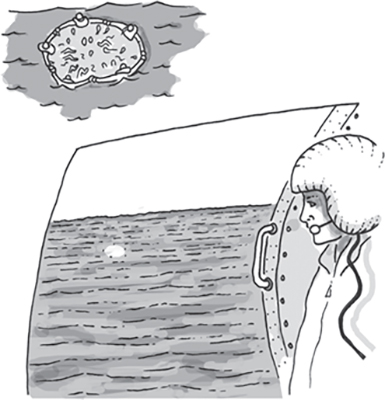
Splashing seen from an aircraft
Sounding off
Remember that three of any sound, repeatedly, is often recognized as a call for help. Use a whistle, bang on the metal remains of a car or plane, even call out for help by cupping your hands around your mouth to amplify your voice. Keep at it and do this at some interval depending on how close you think people might be.
Worldwide distress frequencies and phone numbers
Persons in distress are legally allowed to use any radio transmitter and any frequency when in need of rescue. The following is a list of the radios you’re likely to run into and the channels they commonly use for distress calls.
- Marine Radio (found on watercraft): Channel 16
- CB Radio (often on recreational outdoor vehicles): Channel 9
- Family Radio Service (FRS) (most “walkie-talkies”): Channel 14.
- Single-sideband and amateur (ham) radio (often aboard larger vessels and vehicles): 2182 kHz, 14.300 MHz, 14.313 MHz
- Aviation Band Radio (some are hand-held radios, others are mounted to the control panel in the cockpit): 121.5 MHz, 243MHz
- Cellphones: Try dialing 911 on your cellphone, even if you think you’re not within coverage; then try texting someone who you know checks their texts. Text is often better than voice because it can get through when voice can’t.If you have plenty of battery power, send a text, and then leave the phone on as you travel. The phone searches for reception until it transmits. Getting to higher ground increases the possibility that your cellphone will make contact with a tower.
- 911: U.S., Canada, Central America (partial), Philippines
- 066, 060, 080, 911: Mexico.
- 112: Europe, Australia, New Zealand, Colombia, India, South Korea, South Africa, Israel
- 999, 120: China (PRC)
- 110: Jamaica
- 190, 191: Brazil
- 1669, 191: Thailand
- 113, 115: Vietnam, Chile
- SOS in Morse code: . . . – – – . . . (3 short tones, 3 long tones, 3 shorts)
- International distress signal code word: Mayday, spoken three times

